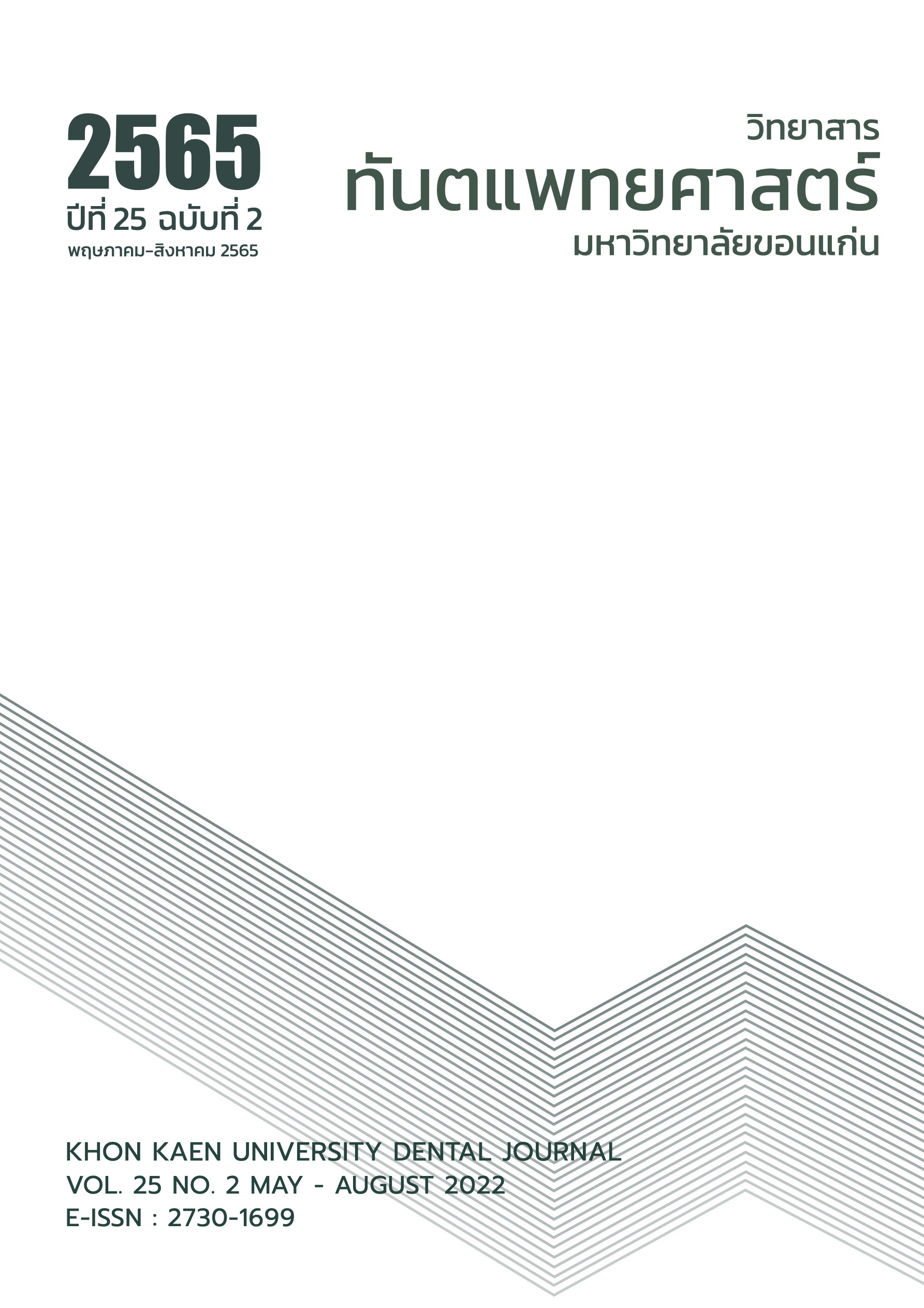Bone Characteristics of the Maxillary Regions Commonly Used for Miniscrew Implant Placement: The Comparison between Different Vertical Skeletal Patterns
Main Article Content
Abstract
The purposes of this study were to evaluate the bone characteristics; the alveolar process width (APW), cortical bone thickness (CBT), cortical bone density (CoBD), and cancellous bone density (CaBD) of the maxillary regions commonly used for miniscrew implant placement and to compare the bone characteristics between patients with different vertical skeletal patterns. Using Cone-beam computed tomography (CBCT) images obtained from 39 patients, age 20-30 years, the APW, CBT and bone density were measured with Dolphin Imaging software. On buccal side, the APW, CBT, CoBD, and CaBD values ranged from 7.95±1.40 to 12.25±3.95 mm, 1.14±0.27 to 1.35±0.33 mm, 1,025.7±157.09 to 1,167.5±181.50 Hounsfield units (HU), and 398.54±45.47 to 408.71±44.48 HU, respectively. On palatal side, the APW, CBT, CoBD, and CaBD values ranged from 9.08±4.39 to 10.79±5.10 mm, 1.28±0.28 to 1.37±0.29 mm, 1,001.5±148.02 to 1,048.2±128.14 HU, and 416.29±41.76 to 421.73±53.74 HU, respectively. Comparing of bone characteristics between vertical skeletal patterns there were no statistically significant difference in this study parameter, except palatal CBT and buccal CaBD in hyperdivergent group were less than other groups. In conclusion, the bone characteristics of the maxillary interradicular spaces from premolar to molar regions were appropriate for miniscrew implant placement and the results indicated that it should be cautiously taken into account when placing miniscrew implants in the patients with hyperdivergent skeletal pattern.
Article Details

This work is licensed under a Creative Commons Attribution-NonCommercial-NoDerivatives 4.0 International License.
บทความ ข้อมูล เนื้อหา รูปภาพ ฯลฯ ที่ได้รับการลงตีพิมพ์ในวิทยาสารทันตแพทยศาสตร์ มหาวิทยาลัยขอนแก่นถือเป็นลิขสิทธิ์เฉพาะของคณะทันตแพทยศาสตร์ มหาวิทยาลัยขอนแก่น หากบุคคลหรือหน่วยงานใดต้องการนำทั้งหมดหรือส่วนหนึ่งส่วนใดไปเผยแพร่ต่อหรือเพื่อกระทำการใด ๆ จะต้องได้รับอนุญาตเป็นลายลักษณ์อักษร จากคณะทันตแพทยศาสตร์ มหาวิทยาลัยขอนแก่นก่อนเท่านั้น
References
Alves Jr M, Baratieri C, Mattos CT, Araújo MTdS, Maia LC. Root repair after contact with mini-implants: systematic review of the literature. Eur J Orthod 2013;35(4):491-9.
Papageorgiou SN, Zogakis IP, Papadopoulos MA. Failure rates and associated risk factors of orthodontic miniscrew implants: a meta-analysis. Am J Orthod Dentofacial Orthop 2012;142(5):577-95. e7.
Watanabe H, Deguchi T, Hasegawa M, Ito M, Kim S, Takano-Yamamoto T. Orthodontic miniscrew failure rate and root proximity, insertion angle, bone contact length, and bone density. Orthod Craniofac Res 2013;16(1):44-55.
Kuroda S, Yamada K, Deguchi T, Hashimoto T, Kyung H-M, Yamamoto TT. Root proximity is a major factor for screw failure in orthodontic anchorage. Am J Orthod Dentofacial Orthop 2007; 131(4):S68-73.
Chen YH, Chang HH, Chen YJ, Lee D, Chiang HH, Jane Yao CC. Root contact during insertion of miniscrews for orthodontic anchorage increases the failure rate: an animal study. Clin Oral Implants Res 2008;19(1):99-106.
Motoyoshi M, Yoshida T, Ono A, Shimizu N. Effect of cortical bone thickness and implant placement torque on stability of orthodontic mini-implants. Int J Oral Maxillofac Surg 2007;22(5):779-84.
Marquezan M, Lima I, Lopes RT, Sant'Anna EF, de Souza MMG. Is trabecular bone related to primary stability of miniscrews? Angle Orthod 2013;84(3): 500-7.
Herman RJ, Currier GF, Miyake A. Mini-implant anchorage for maxillary canine retraction: a pilot study. Am J Orthod Dentofacial Orthop 2006; 130(2):228-35.
Bollero P, Di Fazio V, Pavoni C, Cordaro M, Cozza P, Lione R. Titanium alloy vs. stainless steel miniscrews: an in vivo split-mouth study. Eur Rev Med Pharmacol Sci 2018;22:2191-8.
Fernandes D, Elias C, Ruellas A. Influence of screw length and bone thickness on the stability of temporary implants. Mater 2015;8(9):6558-69.
Misch CE. Dental Implant Prosthetics. 2nd ed. Missouri: Mosby; 2005. 237-50.
Jaffin RA, Berman CL. The excessive loss of Branemark fixtures in type IV bone: a 5-year analysis. J Periodontol 1991;62(1):2-4.
Kravitz ND, Kusnoto B. Risks and complications of orthodontic miniscrews. Am J Orthod Dentofacial Orthop 2007;131(4):S43-51.
Miyawaki S, Koyama I, Inoue M, Mishima K, Sugahara T, Takano-Yamamoto T. Factors associated with the stability of titanium screws placed in the posterior region for orthodontic anchorage. Am J Orthod Dentofacial Orthop 2003;124(4):373-8.
Yi Lin S, Mimi Y, Ming Tak C, Kelvin Weng Chiong F, Hung Chew W. A study of success rate of miniscrew implants as temporary anchorage devices in singapore. Int J Dent 2015;2015:294670.
Proffit W, Fields HW, Nixon W. Occlusal forces in normal-and long-face adults. J Dent Res 1983; 62(5): 566-70.
Abu Alhaija ES, Al Zo'ubi IA, Al Rousan ME, Hammad MM. Maximum occlusal bite forces in Jordanian individuals with different dentofacial vertical skeletal patterns. Eur J Orthod 2009; 32(1):71-7.
Escobar-Correa N, Ramírez-Bustamante MA, Sánchez-Uribe LA, Upegui-Zea JC, Vergara-Villarreal P, Ramírez-Ossa DM. Evaluation of mandibular buccal shelf characteristics in the Colombian population: A cone-beam computed tomography study. Korean J Orthod 2020;51(1):23-31.
Park J, Cho HJ. Three-dimensional evaluation of interradicular spaces and cortical bone thickness for the placement and initial stability of microimplants in adults. Am J Orthod Dentofacial Orthop 2009;136(3):314-5.
Poggio PM, Incorvati C, Velo S, Carano A. “Safe zones”: a guide for miniscrew positioning in the maxillary and mandibular arch. Angle Orthod 2006;76(2):191-7.
21. Alkadhimi A, Al-Awadhi EA. Miniscrews for orthodontic anchorage: a review of available systems. J Orthod 2018;45(2):102-14.
Prado FB, Freire AR, Cláudia Rossi A, Ledogar JA, Smith AL, Dechow PC, et al. Review of in vivo bone strain studies and finite element models of the zygomatic complex in humans and nonhuman primates: implications for clinical research and practice. Anat Rec 2016; 299(12):1753-78.
Park HS, Lee YJ, Jeong SH, Kwon TG. Density of the alveolar and basal bones of the maxilla and the mandible. Am J Orthod Dentofacial Orthop 2008; 133(1):30-7.
Choi JH, Park CH, Yi SW, Lim HJ, Hwang HS. Bone density measurement in interdental areas with simulated placement of orthodontic miniscrew implants. Am J Orthod Dentofacial Orthop 2009;136(6):766-7.
Horner KA, Behrents RG, Kim KB, Buschang PH. Cortical bone and ridge thickness of hyperdivergent and hypodivergent adults. Am J Orthod Dentofacial Orthop 2012;142(2):170-8.
Ozdemir F, Tozlu M, Germec-Cakan D. Cortical bone thickness of the alveolar process measured with cone-beam computed tomography in patients with different facial types. Am J Orthod Dentofacial Orthop 2013;143(2):190-6.
Li H, Zhang H, Smales RJ, Zhang Y, Ni Y, Ma J, et al. Effect of 3 vertical facial patterns on alveolar bone quality at selected miniscrew implant sites. Implant dent 2014;23(1):92-7.


